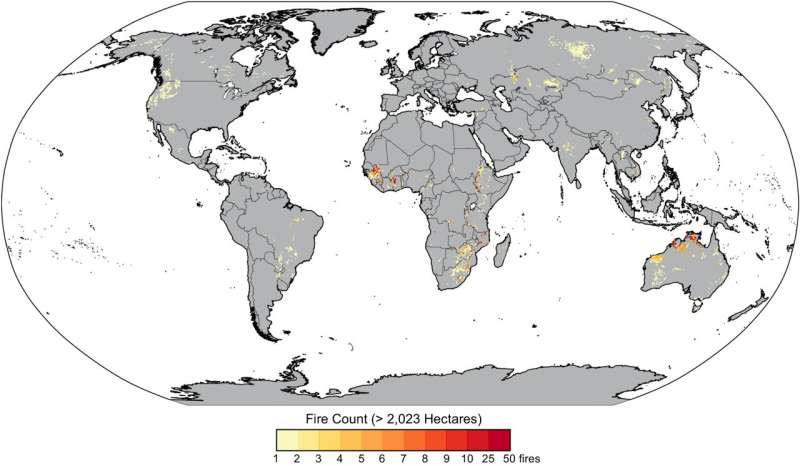This article has been reviewed according to Science X's editorial process and policies. Editors have highlighted the following attributes while ensuring the content's credibility:
fact-checked
peer-reviewed publication
trusted source
proofread
Wildfires can unlock toxic metal particles from soils, study finds

Wildfires can transform a benign metal in soils and plants into toxic particles that easily become airborne, according to a new study from Stanford University.
Published Dec. 12 in Nature Communications, the research documents high levels of a hazardous form of the metal chromium at wildfire sites with chromium-rich soils and certain kinds of vegetation compared to adjacent unburned sites. Known as hexavalent chromium or chromium 6, this is the same toxin made notorious by the 2000 film Erin Brockovich.
"Our study suggests far more attention should be paid to wildfire-modified chromium, and we presume additional metals as well, to more thoroughly characterize the overall threats wildfires pose to human health," said lead study author Alandra Lopez, a postdoctoral scholar in Earth system science at the Stanford Doerr School of Sustainability.
An overlooked hazard
Smoke plumes from wildfires are known to carry dangerous air pollutants, including gases, organic aerosols, and fine particulate matter, which can trigger asthma attacks, heart attacks, and early death.
Scientists and regulators have focused less attention on potential harm from metals like chromium, which is common in soils across the western United States, Australia, Brazil, Europe, Indonesia, and South Africa. With wildfires expected to become more frequent and severe due to climate change, the health risks posed by airborne chromium to firefighters, downwind residents, and others will need to be better understood, the researchers said.
"In the complex mixture of gases and particles that wildfires spew out as smoke and leave behind as dust, heavy metals such as chromium have largely been overlooked," said senior study author Scott Fendorf, the Terry Huffington Professor in the Stanford Doerr School of Sustainability.
Scientific opportunity knocks
In nature, chromium mostly occurs in a form known as trivalent chromium or chromium 3, an essential nutrient that our bodies use to break down glucose. Chromium 6, which increases cancer risk when inhaled or ingested via contaminated drinking water, most often results from industrial processes. High levels of chromium 6 historically have entered the environment from industrial runoff and wastewater.
Although natural chemical processes can trigger this transformation, laboratory experiments led by researchers at Australia's Southern Cross University provided evidence in 2019 that chromium 6 could also form rapidly from chromium 3 in surface soils heated by wildfires.
Intrigued by those findings, Fendorf and Lopez set out to test the theory that wildfires can leave soils contaminated with chromium 6. Focusing on California's North Coast Range, they identified sites in four ecological preserves that have recently burned across soils formed from naturally chromium-rich rocks, such as serpentinite.
Lopez collected soil from the preserves and separated out the smallest particles, which are most sensitive to wind transport. She measured hexavalent chromium concentrations in this ultra-fine dust from burned and unburned areas and gathered data on the local fire severity and the prevailing soil, underlying geology, and ecosystem types, ranging from open grasslands to dense forests.
The researchers found all these factors influenced chromium 6 levels in soil. Most dramatically, in the chromium-rich areas where vegetation allowed fires to burn at high heat for long durations, toxic chromium concentrations came in approximately seven times higher than in unburned areas, suggesting significant amounts of chromium 6 could become airborne.
Mitigating the risks
In terms of exposure risks, fire-induced toxic chromium would initially be encountered by first responders and people living near the conflagrations. Even after fires end, local communities downwind could be exposed because strong winds may carry fine particles of chromium-laced soil.
Much of the risk of inhaling airborne hexavalent chromium would likely decline after the first big rainfall washes the metal away and underground, said Fendorf, who is also a senior fellow at the Stanford Woods Institute for the Environment.
Yet before the rains come—which might take many months, especially as climate change brings more frequent and severe droughts to the American West—exposure risks would loom for people working to revegetate or rebuild burned areas, as well as recreationists checking out burn scars. More research is needed to understand potential threats to ecosystems and human health if fire-induced chromium 6 is washing into waterways or groundwater.
Fendorf said future research into wildfire-related toxic chromium exposure could help inform public health guidance, such as recommendations to wear an N95 mask when visiting a burn site.
To learn more, Lopez is now contributing to an assessment of firefighter health and exposure to metal-containing dusts.
With support from the Stanford Woods Institute for the Environment's Environmental Ventures Program, Fendorf is working with colleagues to develop geospatial tools for predicting threats of toxic chromium generation and downstream exposure. These tools could eventually help researchers develop better ways to limit exposure to chromium and other overlooked metallic pollutants.
"While chromium is one of the metals of highest concern, we're sure it's not the only one," said Fendorf. "We expect subsequent studies to bear out additional metal inhalation exposure risks posed by wildfires."
More information: Alandra Lopez et al, Metal toxin threat in wildland fires determined by geology and fire severity, Nature Communications (2023). DOI: 10.1038/s41467-023-43101-9. www.nature.com/articles/s41467-023-43101-9
Journal information: Nature Communications
Provided by Stanford University




















